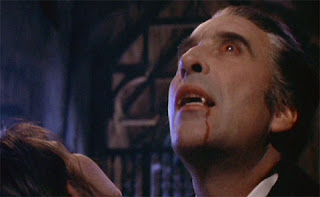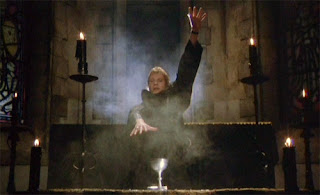Now Playing: Dracula A.D. 1972 (1972)
Pros: Peter Cushing’s gravitas offsets some of the cringe-inducing aspects of the film; Stephanie Beacham is very good as Cushing’s granddaughter, Jessica Van Helsing.
Cons: The film’s attempt to capture the look and lingo of ‘70s London youth culture descends to near-parody.
Pros: Peter Cushing’s gravitas offsets some of the cringe-inducing aspects of the film; Stephanie Beacham is very good as Cushing’s granddaughter, Jessica Van Helsing.
Cons: The film’s attempt to capture the look and lingo of ‘70s London youth culture descends to near-parody.
In part one of my examination of Hammer’s early ‘70s attempt to crack the youth market, I reviewed Taste the Blood of Dracula (1970). Despite the lurid title, the film was a not-so-subtle dig at the establishment, what with almost all the adult characters being corrupt or incompetent, and a climax that had the young protagonists saving the day without any help from their useless elders.
Just a little over two years after Taste the Blood, Hammer released Dracula A.D. 1972, which on the surface looked to be an extreme concession to the youth market, set in the (then) present day and full of sex, drugs and rock-n-roll. And yet, the underlying message is a mirror image to the previous film’s -- this time, it’s the younger generation’s turn to be almost uniformly corrupt and/or incompetent, and the old guard’s turn to save their butts from the evil they’ve unwittingly released.
 |
| "Hmmm, dense and full-bodied, with overtones of weed, barbiturates and vodka, and just a hint of espresso..." |
“Bloody Dracula” Recipe (with apologies to Bloody Mary)
1 vial of Dracula’s ashes
Liberal amount of blood from an acolyte or sacrificial victim
1 de-sanctified church
A group of bored, corruptible disciples
1 Black Mass
Optional: Dracula’s cape or ring
Mix the first two ingredients while celebrating the Black Mass with your disciples in the de-sanctified church. Wearing Dracula’s cape and/or ring is not required, but it looks cooler. Skol!
The creepy instigator in A.D. 1972 is Johnny Alucard (hmmm, that name seems familiar somehow), played by Christopher Neame. Johnny is part of a group of “with it” kids who have grown bored with their usual routine of crashing adult parties, smoking pot, and hanging out at bars until the wee hours.
Johnny proposes that they do something “way, way out,” by celebrating a black mass at the local abandoned, de-sanctified church. Most of the group thinks it might be good for some “giggles,” but Jessica Van Helsing (Stephanie Beacham) and her boyfriend Bob (Philip Miller) are leery of playing around at something so dark and twisted. Still, they relent and everyone agrees to meet at midnight at the church.
Little do they know that Johnny is a deadly serious descendant of a disciple of Dracula’s, and intends to resurrect the Count on the 100th anniversary of the battle between the vampire and Lawrence Van Helsing that resulted in both their deaths.
Jessica and Bob are even more weirded out when they discover Van Helsing’s grave marker in the churchyard (Jessica is a great-granddaughter), and realize the significance of the date. But, peer pressure being what it is, they participate anyway.
 |
| Johnny violates the laws of God and Man, and London's regulations banning smoking in public places. |
Johnny wants Jessica to come to the altar to complete the ritual, but she freezes like a deer in the headlights, knowing that something is definitely not right. Jessica’s friend Laura (Caroline Munro), gets caught up in the moment and enthusiastically volunteers (a decision she will very quickly regret).
Before you can say “Alucard,” there is the glint of the ritual knife, pouring blood, and Dracula’s ashes boiling up like an infernal stew. When Johnny pours the bloody mess all over Laura’s heaving chest, the other kids scatter to the four winds. Jessica doesn’t want to leave the sobbing Laura behind, but Bob’s self-preservation instincts win out and he drags her away.
Johnny delivers the coup-de-grace when he removes the stake (the splintered carriage spoke that killed Dracula a century before) from the Count’s remains, which were surreptitiously buried on the church grounds near Van Helsing’s.
Laura learns an important life lesson -- never voluntarily lie on a de-sanctified altar during a Black Mass -- but unfortunately it goes to waste as she becomes the revivified Count’s first victim. Her body, drained of blood, is discovered at a construction site near the church. Meanwhile, Johnny, who witnessed her demise, coolly tells his friends that she’s gone off to visit family.
 |
| Jessica tells her grandfather all about the peer pressure to smoke, drink, do drugs, and conduct ritual sacrifices. |
The inspectors interview Lorrimer first, who, upon learning that Laura’s body was drained, schools the skeptical policemen on the “positive proof” of vampires and his own grandfather’s battle with Dracula. “There are dark corners, horrors almost impossible to imagine, even in our worst nightmares,” he informs them. However, Lorrimer’s academic interest in a possible case of vampirism turns into real concern when he learns that his granddaughter is involved.
Scotland Yard turns out to be the least of their concerns, as Dracula, with the aid of disciple Johnny, begins hunting down the kids with the ultimate aim of wreaking vengeance on all living Van Helsings.
In Taste the Blood of Dracula, the young Londoners were both the instrument of Dracula’s revenge and his undoing. The corrupt, hypocritical Victorian establishment was responsible for the Count’s resurrection, and only incorruptible youth could save the day. Fast forward to 1972, and it’s now the establishment’s turn (in the form of Scotland Yard and the astute, scholarly Lorrimer Van Helsing) to save London from the actions of clueless youngsters.
 |
| Sex, drugs and black masses don't seem to be doing the trick for the callow youths of London. |
In both films, Dracula is the dark, merciless Karma that catches up with the hypocritical hedonists of the leisure class, young and old. Both are subversive in the sense that, in spite of the obvious suffering of the victims, there’s a little piece of us (or maybe a big piece) thinking that they're getting what they deserve.
A.D. 1972’s counter-counterculture message is that the kids are definitely not alright, that in their selfishness and hedonism they are nothing but spoiled lambs to the slaughter in the face of evil -- with the exception of Jessica of course, who after all, is a Van Helsing. Jessica’s head and heart are in the right place, but she has problems resisting peer pressure.
Stephanie Beacham is very natural and authentic portraying a girl torn between pleasing her less cautious, less intelligent friends and living up to her grandfather’s faith in her. Peter Cushing is a delight as usual as the refined, empathetic Lorrimer, surrounded by books and artifacts accumulated over a long academic career, yet willing to step up and be a man of action when the circumstances call for it. Their scenes together -- he, the doting, concerned grandfather; she, grateful for the concern but also feisty and wanting to live life on her own terms -- save the film from being just a cheesy horror genre rip on youth culture.
** SPOILERS: PROCEED WITH CAUTION! **
A.D. 1972 once again calls for Van Helsing to put aside his books and gentlemanly manner and become a man of geri-action. Since Cushing was pushing 60 at the time, he wasn’t required to get quite as physical as in earlier roles, but in vampire hunter mode he still is stabbed with a switchblade, chased up the old church stairs, and generally thrown around like a rag doll (okay, so I'm sure there was a stunt man involved, but still...).
 |
| Johnny is upset about missing his morning nap. |
Sidebar: At the Monster Bash convention in Mars, PA this past June, Christopher Neame was asked about his experiences on the set of A.D. 1972. Being only 23 at the time, he recalled that the slender, self-effacing Cushing was as "strong as an ox,” during filming of the fight scenes. He also laughed about his death scene. Back in the day, English film crews observed strict union rules and hours. Once the director yelled cut, everyone cleared out, leaving him soaked and in full makeup.
With one disciple down, Van Helsing must confront Dracula in his lair, the abandoned church, where Jessica is hypnotized and laid out on the altar. Before it’s all over, he will have to pull out all the stops and all his vampire-fighting tools, including holy water, a silver-bladed knife, and a special surprise trap in the churchyard. The coup-de-grace he administers to Dracula is particularly brutal.
 |
| Jessica Van Helsing does her best imitation of the lady on all those truck mudflaps. |
Dracula A.D. 1972 is a competent, traditional Hammer vampire story wrapped up in Mod packaging in a fairly cynical attempt to keep the kids flocking to the theaters and drive-ins. The depiction of London youth culture is as phony as a three-dollar bill (or should I say three pound note?), dreamed up by middle-aged writers and producers who seem to have done their research looking at tabloids and bad TV shows.
Still, if you can get past the cringey pandering, there are good performances (especially Cushing and Meacham), touching scenes between grandfather and granddaughter, and exciting action sequences.
As mentioned previously, Christopher Neame was a newcomer at the time, having only appeared in a small role in Hammer’s Lust for a Vampire (1971) and a couple of TV series before scoring as pasty-faced Johnny Alucard. He since has done dozens of movies and TV series, including stints on Star Trek: Voyager and Star Trek: Enterprise. He’s still working, having recently made the Hammer homage House of the Gorgon (2019) with scream-queen icons Caroline Munroe, Veronica Carlson, and Martine Beswick and independent filmmaker Jamie Kennedy.
 |
| "Look here Van Helsing, this is how you do the Monster Mash!" |
I’ll leave the final word with Marcus Hearn and Alan Barnes, the “biographers” of Hammer Films:
“[T]he film has long-suffered a reputation as a monumental misjudgement. … Dracula A.D. 1972 gets more entertaining with the passing of time, and is perhaps best enjoyed as an endearing, if naive, picture of an era that never was.” The Hammer Story: The Authorised History of Hammer Films, Titan Books, 2007, p. 157.Where to find it: Dracula A.D. 1972 shares space with Taste the Blood of Dracula on a disc in the 4 Film Favorites: Draculas collection, available here.


A fabulous under rated film.
ReplyDeleteThese days is looked on more favourably.
Lee and Crushing and supreme in this film.
The opening is Fabulous as his Dracula's return and demise.
Still my favourite.
Clive Eardley
Agreed! This is the most underrated and under-appreciated of all of Hammer's Draculas.
DeleteI'm a big fan of Hammer's early 70s movies. They were trying desperately to come up with new variations on old themes and I think they were doing a pretty good job of it. I hated DRACULA AD 1972 the first time I saw it, I quite liked it the second time and I liked it a lot the the third time around.
DeleteThat's exactly my progression with Dracula AD 1972 - disliked it the first time, but warmed up to it with repeated viewings.
DeleteThis is definitely good fun and I love it. It's a real guilty pleasure especially for those musical numbers.
ReplyDeleteYes indeed, this is the ultimate Hammer film for a groovin' watch party!
Delete